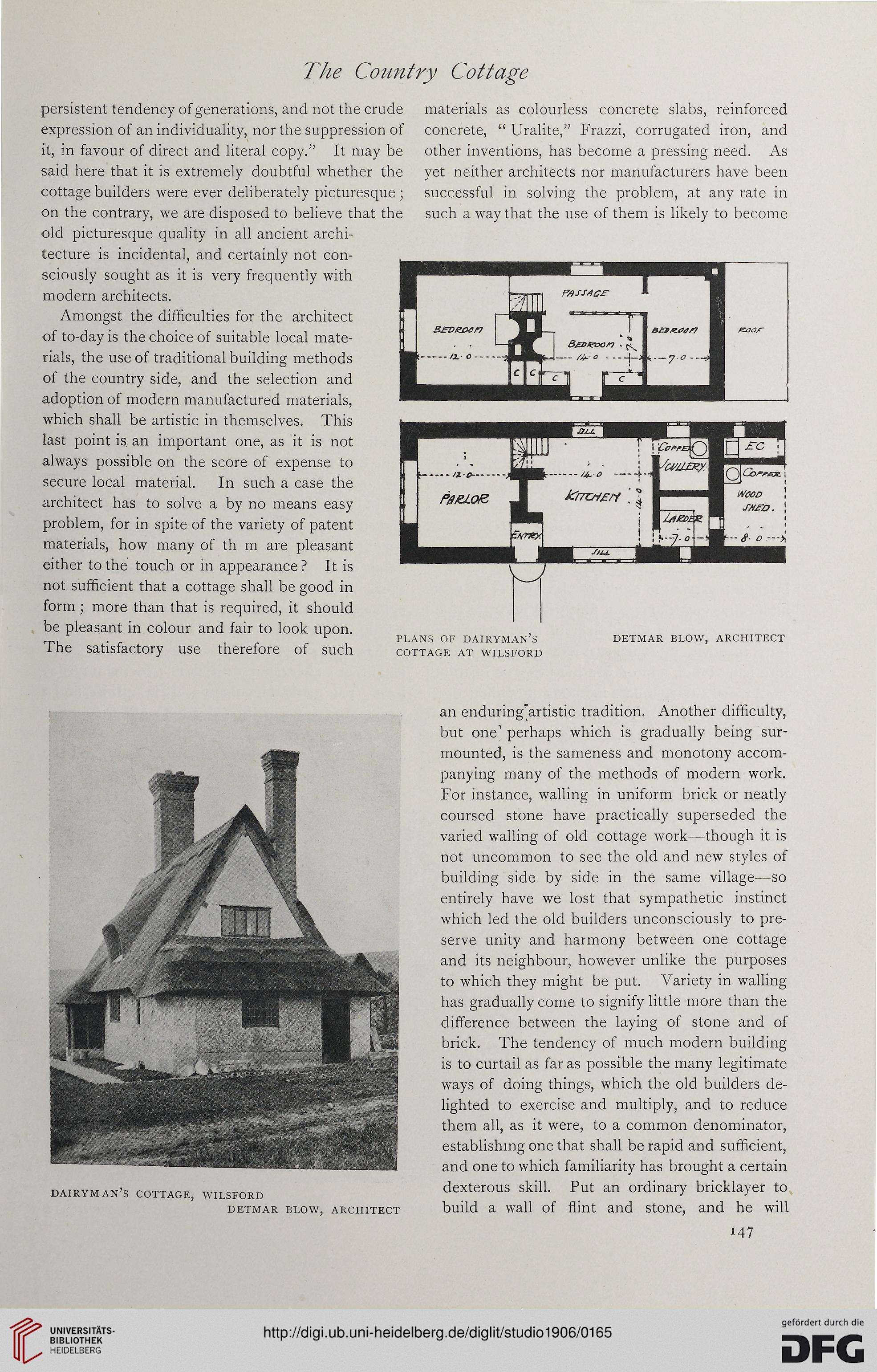The Country Cottage
persistent tendency of generations, and not the crude
expression of an individuality, nor the suppression of
it, in favour of direct and literal copy.” It may be
said here that it is extremely doubtful whether the
cottage builders were ever deliberately picturesque ;
on the contrary, we are disposed to believe that the
old picturesque quality in all ancient archi-
tecture is incidental, and certainly not con-
sciously sought as it is very frequently with
modern architects.
Amongst the difficulties for the architect
of to-day is the choice of suitable local mate-
rials, the use of traditional building methods
of the country side, and the selection and
adoption of modern manufactured materials,
which shall be artistic in themselves. This
last point is an important one, as it is not
always possible on the score of expense to
secure local material. In such a case the
architect has to solve a by no means easy
problem, for in spite of the variety of patent
materials, how many of th m are pleasant
either to the touch or in appearance ? It is
not sufficient that a cottage shall be good in
form; more than that is required, it should
be pleasant in colour and fair to look upon.
The satisfactory use therefore of such
materials as colourless concrete slabs, reinforced
concrete, “ Uralite,” Frazzi, corrugated iron, and
other inventions, has become a pressing need. As
yet neither architects nor manufacturers have been
successful in solving the problem, at any rate in
such a way that the use of them is likely to become
PLANS OF DAIRYMAN’S DETMAR BLOW, ARCHITECT
COTTAGE AT WILSFORD
DAIRYMAN’S COTTAGE, WILSFORD
DETMAR BLOW, ARCHITECT
an enduring^artistic tradition. Another difficulty,
but one’ perhaps which is gradually being sur-
mounted, is the sameness and monotony accom-
panying many of the methods of modern work.
For instance, walling in uniform brick or neatly
coursed stone have practically superseded the
varied walling of old cottage work—though it is
not uncommon to see the old and new styles of
building side by side in the same village—so
entirely have we lost that sympathetic instinct
which led the old builders unconsciously to pre-
serve unity and harmony between one cottage
and its neighbour, however unlike the purposes
to which they might be put. Variety in walling
has gradually come to signify little more than the
difference between the laying of stone and of
brick. The tendency of much modern building
is to curtail as far as possible the many legitimate
ways of doing things, which the old builders de-
lighted to exercise and multiply, and to reduce
them all, as it were, to a common denominator,
establishing one that shall be rapid and sufficient,
and one to which familiarity has brought a certain
dexterous skill. Put an ordinary bricklayer to
build a wall of flint and stone, and he will
i47
persistent tendency of generations, and not the crude
expression of an individuality, nor the suppression of
it, in favour of direct and literal copy.” It may be
said here that it is extremely doubtful whether the
cottage builders were ever deliberately picturesque ;
on the contrary, we are disposed to believe that the
old picturesque quality in all ancient archi-
tecture is incidental, and certainly not con-
sciously sought as it is very frequently with
modern architects.
Amongst the difficulties for the architect
of to-day is the choice of suitable local mate-
rials, the use of traditional building methods
of the country side, and the selection and
adoption of modern manufactured materials,
which shall be artistic in themselves. This
last point is an important one, as it is not
always possible on the score of expense to
secure local material. In such a case the
architect has to solve a by no means easy
problem, for in spite of the variety of patent
materials, how many of th m are pleasant
either to the touch or in appearance ? It is
not sufficient that a cottage shall be good in
form; more than that is required, it should
be pleasant in colour and fair to look upon.
The satisfactory use therefore of such
materials as colourless concrete slabs, reinforced
concrete, “ Uralite,” Frazzi, corrugated iron, and
other inventions, has become a pressing need. As
yet neither architects nor manufacturers have been
successful in solving the problem, at any rate in
such a way that the use of them is likely to become
PLANS OF DAIRYMAN’S DETMAR BLOW, ARCHITECT
COTTAGE AT WILSFORD
DAIRYMAN’S COTTAGE, WILSFORD
DETMAR BLOW, ARCHITECT
an enduring^artistic tradition. Another difficulty,
but one’ perhaps which is gradually being sur-
mounted, is the sameness and monotony accom-
panying many of the methods of modern work.
For instance, walling in uniform brick or neatly
coursed stone have practically superseded the
varied walling of old cottage work—though it is
not uncommon to see the old and new styles of
building side by side in the same village—so
entirely have we lost that sympathetic instinct
which led the old builders unconsciously to pre-
serve unity and harmony between one cottage
and its neighbour, however unlike the purposes
to which they might be put. Variety in walling
has gradually come to signify little more than the
difference between the laying of stone and of
brick. The tendency of much modern building
is to curtail as far as possible the many legitimate
ways of doing things, which the old builders de-
lighted to exercise and multiply, and to reduce
them all, as it were, to a common denominator,
establishing one that shall be rapid and sufficient,
and one to which familiarity has brought a certain
dexterous skill. Put an ordinary bricklayer to
build a wall of flint and stone, and he will
i47





